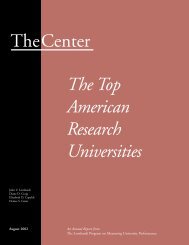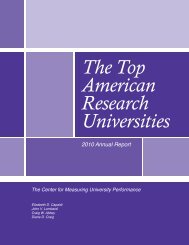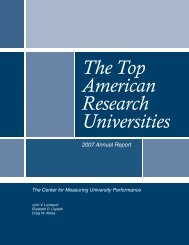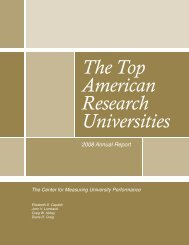TheCenter The Top American Research Universities
2005 - The Center for Measuring University Performance - Arizona ...
2005 - The Center for Measuring University Performance - Arizona ...
You also want an ePaper? Increase the reach of your titles
YUMPU automatically turns print PDFs into web optimized ePapers that Google loves.
<strong>Research</strong> FocusNSF/SRS Survey of R&D Expenditures at <strong>Universities</strong> andColleges, FY 2003.In addition to reporting expenditure data by sourceof funds, NSF identifies in what major disciplines themoney is expended. In the <strong>Research</strong> by Disciplinetable (Data Tables, pp. 58), we provide the proportionof total and federal expenditures in each disciplinefor those institutions with more than $20 million infederal research. <strong>The</strong>se data are useful for developinggroups of similar institutions for peer analysis.<strong>The</strong> Institutional Characteristics table (Data Tables,pp. 154) provides a summary measure of an institution’sresearch strength and concentration based onthese discipline-level expenditures. <strong>Universities</strong> with95-100% of their federal research dollars spent in oneparticular discipline are coded as “all.” We identifyinstitutions with 75-94% in one area as “heavy” andlabel those with 50-74% of their expenditures concentratedas “strong.” Other universities with 25-49% inone or more disciplines we describe as “moderate.” Afew institutions (but none in the more than $20 milliongroup) have expenditures distributed fairly evenlyacross the disciplines; those we code as “mixed.”In some cases, where an institution reports as amulti-campus entity, we made adjustments to breakout the discipline-level expenditure data by singlecampus. Typically, this involved moving all or a portionof the life sciences expenditures to the health ormedical center campus. IPEDS fall enrollment andgraduate degrees by discipline data also were used tohelp in this effort.While these data offer some insight as to theresearch structure of a university, their usefulness islimited. For example, we may be tempted to use thelife sciences as a surrogate for medical research, but wemust remember that they also include agricultural andbiological sciences. Further, the growing trend towardmultidisciplinary and interdisciplinary projects maymake it more difficult for universities to accuratelyreflect expenditures by discipline or sub-discipline.<strong><strong>The</strong>Center</strong> chooses not to break out these sub-disciplinesbecause the data are increasingly prone to erroras further adjustments are made.Student CharacteristicsFall EnrollmentSource: NCES IPEDS Fall Enrollment Survey, 2003.Each November, institutions report their currentfall headcount enrollment to the IPEDS Fall EnrollmentSurvey. Enrollment figures include both degreeseeking and non-degree seeking students. <strong><strong>The</strong>Center</strong>provides the headcount enrollment by level as presentedby IPEDS, along with the percentage of thoseattending part-time. Graduate students include thoseseeking specialist degrees in engineering and education.First professional students include those seekingdegrees in medical fields, such as Chiropractic, Dentistry,Medicine, Optometry, Osteopathic Medicine,Pharmacy, Podiatry, and Veterinary Medicine, as wellas those seeking degrees in Law and <strong>The</strong>ology.Each campus in our study submits enrollment databy campus, except for the few institutions identifiedin our Data Notes section. Because this is an informationalitem and not one of <strong><strong>The</strong>Center</strong>’s nine qualitymeasures, we did not attempt to adjust these figures.Page 234Total <strong>Research</strong> Expenditures








